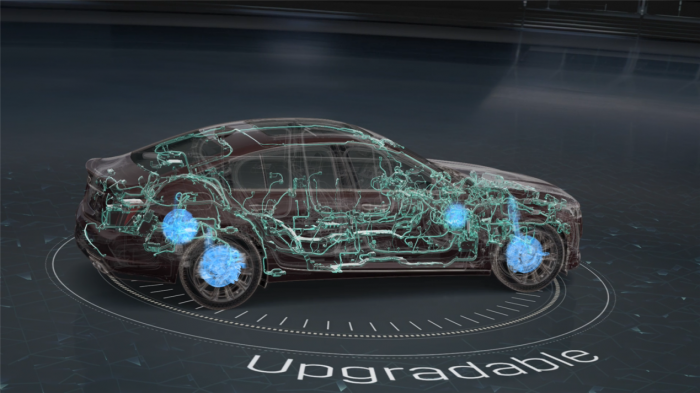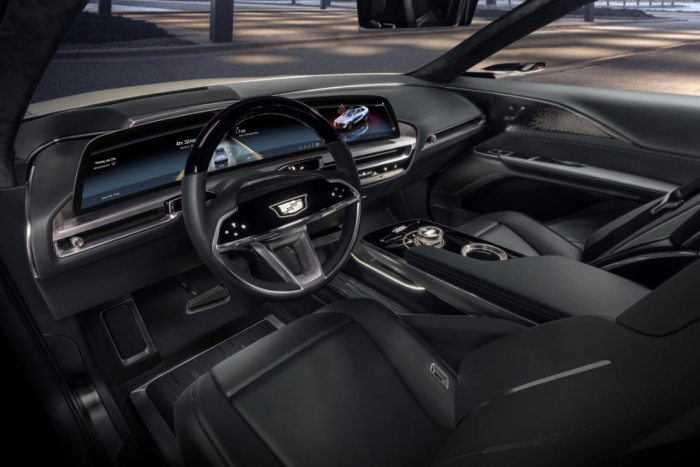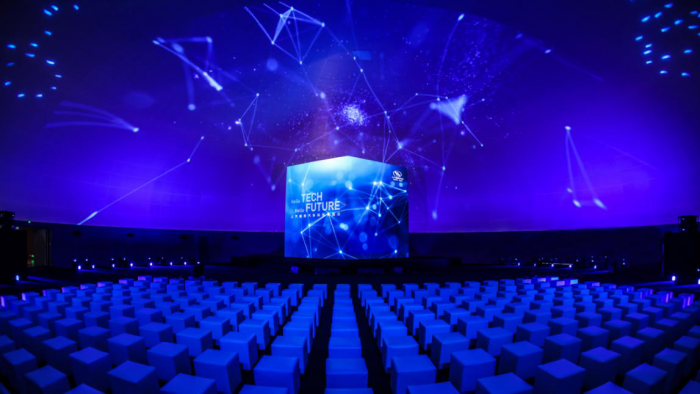Author: Wang Xuan
Regarding the name “Tech Day”, I believe it’s already become commonplace, especially in the past five years of the rapidly developing “new energy vehicle” industry where “tech” is a commonly used term. However, I often contemplate one question: what does “tech” really represent? At the very least, the core of this word should be “technical”. Therefore, it seems that many of the previous “Tech Days” we participated in where high computing power platforms and stacked battery energy density were the focus, were actually misleading and couldn’t withstand scrutiny. If new technologies can be accomplished under the support of capital, what use is there for historical accumulation?
On April 8th 2021, SAIC-GM held a Tech Experience Day in Shanghai. In addition to innovative technology, I also witnessed the imagination of traditional automobile manufacturers. The amount of information revealed during the event was immense, mainly revolving around four major areas: foundational platform, electronic architecture, intelligent cockpit, and intelligent driving. Numerous innovative technologies and upgraded functions were also presented to the public, so let’s break down and analyze these various technologies released in the four major areas of SAIC-GM.
Ultium platform, the pioneer of wireless battery management technology
Ultium is a revolutionary three-electricity platform in SAIC-GM’s electric vehicle layout. Its platform advantages include: high safety, high flexibility, and high intelligence, all of which come from an IoT cross-border innovation technology – wBMS wireless battery management technology.

Currently, mainstream battery management technologies on the market are centralized, semi-distributed, and distributed. Volkswagen’s MEB platform and Tesla use distributed battery management technology. The advantage of distributed technology is that battery cells are assembled into modules, and the health of the battery can be managed by module, thereby avoiding the situation where one damaged module affects the entire battery pack. However, the downside is also very obvious. Since the control network is a multi-level layout, a large number of harnesses are needed to complete the communication between modules.
Wireless management technology can directly address the pain points of distributed battery management technology. Modules can communicate with each other through wireless signals, reducing up to 90% of the harnesses inside the battery, reducing signal attenuation of the harnesses, optimizing battery space and weight, while also reducing costs.
For safety, wireless battery management technology can build a double protection for the battery pack. The first layer is software protection. The Ultium platform has developed a real-time intelligent battery monitoring system for the entire vehicle through the wBMS wireless battery management system. This set of control logic can monitor the health of the battery pack in real-time, differentiate the safety risks of the entire battery system to the pre-detection of individual battery cells, and adjust the modules and sensors accordingly to ensure the health of the battery throughout the vehicle’s lifecycle.The second layer comes from structural protection. The reduction of 90% of the internal wiring harness in the battery provides engineers with more design space. The simplest approach is to fill the space with battery cells again to increase the energy density per unit volume of the entire battery pack. While the Ultium platform does indeed increase the energy density of the entire battery pack through the more abundant space, engineers only use a portion of that space to achieve this. The other part is designed to create an exhaust channel and safety valve, enhancing the heat diffusion capability of the battery from the module to the pack level. Currently, this design on the Ultium platform is patented.
The most commonly seen battery safety test among consumers is likely the needle puncture test that is often reported in the media. The purpose of this test is to cause a short circuit in a single battery cell to quickly and intensely release the energy inside the cell, generating heat. However, in most cases, battery packs face more challenges from compression and abnormal charging, which can cause short circuits and lead to thermal runaway. To address this, the Ultium platform incorporates seven layers of protection, including a real-time intelligent monitoring system, nano-level aerogel, safety valve, and exhaust channel as well as arc prevention design, integrated fully independent liquid cooling system, and aerogel fireproof blanket. Moreover, its new battery physical protection architecture adopts a high-strength cross-shaped frame structure, with ultra-high-strength steel accounting for 37.5% and high-strength steel accounting for about 61%, surpassing the national standard for crush resistance by three times. With a sealing rating of IP67 for dust and water resistance and IP6K9K for high-pressure water protection, the Ultium platform is designed to provide a five-star safety design standard for electric vehicles in terms of voltage, energy, physical protection, and insulation of the power system load terminal.
With the help of the wBMS wireless battery management technology, the Ultium platform has made breakthroughs in intelligence. Based on this technology, the platform’s development space and technological flexibility have been greatly improved. Coupled with General Motors’ new generation of VIP intelligent electronic architecture, it will support more refined system management and iterative upgrades in functionality.
Without the burden of wiring harnesses, the Ultium platform gains greater battery pack flexibility. It uses replaceable, upgradable battery modules as well as flexible battery cell arrangements to easily support upgrades and optimization of cell formulas, whether it is lithium iron phosphate, ternary lithium batteries, or future lithium-metal or solid-state batteries.Through the modular design of battery and electric drive modules, the Ultium platform can combine 12-16 battery cells into 6, 8, 10, 12 and 24 module battery packs, which can be arranged horizontally, vertically or stacked in battery trays. Six different energy density battery packs combined with three motors will provide up to 19 power units. Currently, the Ultium platform will offer seven driving configurations in the Chinese market, including various vehicle sizes to meet the needs of different market segments and reduce product development cycles, accelerating SAIC-GM’s transformation to electrification.
We have always believed that in the era of electric vehicles, all car companies in the world will face a reshuffle. And now is the opportunity for Internet car companies to enter the automotive industry in a big way. However, SAIC-GM’s technology day still shows us the gap between traditional automakers and Internet companies. On the Ultium platform, we see the imagination of traditional automakers for cars. The wBMS wireless battery management technology is “all-inclusive” and connects many aspects of platform structure, layout and functionality.
Another very important point is “landing.” Cars are different from consumer products, and their life cycle is longer, so the requirements for safety and stability are higher. Especially in the era of intelligent cars, every component on the car needs to maintain communication during driving. If there is a problem with the communication link, it is undoubtedly a disaster for intelligent electric vehicles. The Ultium platform, equipped with wBMS wireless battery management technology, needs to communicate the most important battery components wirelessly, not only to ensure stability, avoid signal interference, frequency hopping and data damage, but also to pass strict car-level tests.
The Ultium platform is rated ASIL-D in the ISO26262 functional safety standard evaluation, which is the highest level that all OEMs are trying to avoid. The safety standard evaluation is divided into QM, A, B, C, and D levels, and the development cost and technical difficulty required for each level increase geometrically. The difficulty coefficient of realizing system functional safety for the Ultium platform is no less than that of realizing L4 autonomous driving at this time. This shows that the birth of the Ultium platform is not only the power of capital, but also the accumulation of technology and car-making experience play a crucial role.
The New VIP Electronic Architecture and Intelligent Cockpit Driven by Qualcomm 8195 ChipIn the era of intelligence, one thing that cannot be ignored is the electronic architecture and intelligent cockpit. SAIC General Motors’ new generation of VIP intelligent electronic architecture, as a powerful technical center connecting and controlling almost all vehicle functions, has high-speed network data transmission capabilities, vehicle-level OTA update functions, aviation-grade network security, and unlimited sustainable expansion potential. It connects “cloud, management, and terminal” to provide powerful support for software-defined cars and car intelligence. By 2025, all new models of SAIC General Motors’ three major brands will use this new electronic architecture, and products and technologies based on this architecture will continue to bring consumers a more agile, safe, and intelligent travel experience.

Based on the new generation of VIP intelligent electronic architecture, the new generation of VCS virtual cockpit system developed by SAIC General Motors integrates the world’s top hardware configurations and industry-leading interactive technologies, bringing intelligent and efficient, seamlessly connected multidimensional experiences and rich functionality from functions, interactions to services. The system is equipped with the strongest industry-standard high-performance vehicle-grade SoC, a 33-inch curved ultra-high-definition display, the world’s leading binocular depth laser AR-HUD, and a new generation of intelligent voice assistants and other high-specification hardware and technologies, perfectly combining the interconnection ecology with intelligent scene engine, providing scene services such as seamless parking, smart energy supplement, remote travel, and commuter planning, and cooperating with interconnectivity applications such as Baidu Map, QQ Music, and iQiyi.
At the SAIC General Motors Science and Technology Day, there was also explosive news about the intelligent cockpit. They will use Qualcomm’s 8195 chip in future products. Most of the host factories that cooperate with Qualcomm still use the 820A and 8155 chips. Although these two chips have become mainstream cockpit chips, there is still great potential for host factories to develop them. And now there is a trend to integrate ADAS functions with strong image recognition requirements, such as active braking AEB and driver monitoring system DMS, into cockpit chips. Therefore, when SAIC General Motors announced that they will use the 8195 chip, one speculation is that they will integrate some ADAS functions into the cockpit chip.
 After further investigation, it turns out that SAIC-GM is not in the way they thought. First of all, the resolution of the 33-inch surround-type hyper retina screen equipped with the new generation VCS virtual cockpit system is very high and has dual-depth laser AR-HUD function, which requires high driving resources and computing power. Therefore, they have taken the lead in designing the 8195 chip to drive the multi-screen input. Secondly, in terms of the chip itself, the main difference between the 8195 and the 8155 is the GPU. Although the performance of the 8195 chip is better, the gap between the two is not as great as that between the 820A and the 8155.
After further investigation, it turns out that SAIC-GM is not in the way they thought. First of all, the resolution of the 33-inch surround-type hyper retina screen equipped with the new generation VCS virtual cockpit system is very high and has dual-depth laser AR-HUD function, which requires high driving resources and computing power. Therefore, they have taken the lead in designing the 8195 chip to drive the multi-screen input. Secondly, in terms of the chip itself, the main difference between the 8195 and the 8155 is the GPU. Although the performance of the 8195 chip is better, the gap between the two is not as great as that between the 820A and the 8155.
At the same time, a lot of computing power is also required to drive the car entertainment system, so ADAS relies on another processor. However, there are some functions related to intelligent driving display or customer interaction that depend on the 8195 chip, but not on the 8195 chip for computing power support.
Although “new car-making” companies do not have rich experience in car-making, they have stronger Internet genes and stronger market insight into automotive intelligence and interconnection, and respond more quickly. Therefore, a trend has emerged in the Chinese intelligent automobile market, where “new car-making” companies are striving to pull away from traditional automakers through faster iteration of chip computing power in intelligence, and at the same time, promote and raise customer awareness of intelligent automobiles through publicity, thus eroding the market of traditional automakers.
This is also a problem that SAIC-GM must face. Even if the underlying capabilities are strong, it is impossible to gain an foothold in the market when the upper-level functions cannot keep up with the times. Moreover, China’s process of automobile networking is faster than other regions, so “localization” is very important. In this regard, SAIC-GM will entrust the research and development of the vehicle networking and vehicle entertainment system to the China team of Pan Asia for design and development.
Enhanced Super Cruise Intelligent Driving System
Relying on General Motors’ strong technology reserve, SAIC-GM is actively promoting the landing of advanced autonomous driving technology in China and the continuous expansion of application scenarios. On the basis of Super Cruise system has been installed on Chinese mass-produced cars, this year, the enhanced Super Cruise ultra-intelligent driving system will be launched on Cadillac models, adding more auxiliary functions such as command lane changing. In the next five years, Super Cruise ultra-intelligent driving system will cover most of the Cadillac brand models, gradually applied to future new models of Buick and Chevrolet brands; lane centering intelligent cruise control function will be applied to more than 80% of the three major brand models, and in Ultium platform models to achieve 100% coverage.The upgraded Super Cruise intelligent driving system’s additional features are no longer new in the Chinese market, and some brands have even recently launched “hands off” navigational assistance driving systems based on high-precision maps. In my opinion, SAIC-GM’s approach is not “conservative”, but rather, it aims to provide consumers with the best possible functional experience in an environment where policies are clear.
GM has acquired multiple autonomous driving start-ups in the US to ensure technological iteration. In the American market, GM is also promoting hands off assisted driving. However, this functional point is still in a gray area in China. It would be very rash to bring this function and technology into the Chinese market. Furthermore, assisted driving functions also involve data and privacy issues which are very sensitive in China. These are inevitable issues that will arise when opening up navigational “hands off” assistance driving functions. Therefore, SAIC-GM is waiting for further clarification of policy environment before introducing new technologies into the Chinese market.
In the game between functions and policy, car companies have to make concessions. However, the Super Cruise function is currently in a state of joint development between China and the US. The Chinese team is more familiar with China’s road environment and driving scenes and has an absolute voice in pushing forward the segmented functions of the Chinese version of Super Cruise. Therefore, under the conditions permitted by policies, SAIC-GM can still ensure the competitiveness of the Super Cruise function in the Chinese market.
In conclusion, the globalization of the automotive industry has given rise to a huge supplier system, making car manufacturing easier and easier. As long as there is accurate vehicle logic, a car can be assembled through procurement. However, we must never ignore the imagination of the main factory. Technology is always the driving force behind the development of cars, and innovation has led SAIC-GM to lead the industry, while also promoting other car companies to follow the same technological path. I believe that someday in the future, the automotive industry will undergo a major reshuffle due to automation. The person who holds the technological leadership during this reshuffling process will ultimately emerge victorious.
This article is a translation by ChatGPT of a Chinese report from 42HOW. If you have any questions about it, please email bd@42how.com.
